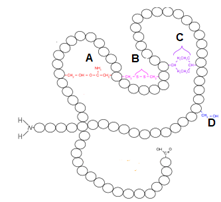An enzyme catalyzed reaction has a △G of -30 Kcal/mol. The amount of enzyme is doubled. What will be the △G for the new reaction?
1. -60 kcal/mol
2. -30 kcal/mol
3. +30 kcal/mol
4. +60 kcal/mol
1. -60 kcal/mol
2. -30 kcal/mol
3. +30 kcal/mol
4. +60 kcal/mol
If you compare the Km values for the enzymes that remove glucose from the blood in liver and brain, you expect that:
1. the value will be higher for the enzyme found in brain
2. the value will be exactly ten times lower for the enzyme found in liver
3. the values for two enzymes will be same
4. the value will be lower for the enzyme found in brain
Which of the following pairs of amino acids is only ketogenic and not glucogenic?
1. Leucine and Lysine
2. Tyrosine and Tryptophan
3. Glutamic acid and Aspartic acid
4. Alanine and Arginine
In the given diagram showing the tertiary structure of a protein, the disulfide bond is shown by the letter:

1. A
2. B
3. C
4. D
Consider the given two statements:
I. A double-stranded DNA rich in G and C needs more energy to be broken than one that is rich in A and T.
II. While the ratio of G to C and A to T in an organism's DNA is fixed, the GC content can vary considerably from one DNA to another.
1. Both I and II are correct and II explains I
2. Both I and II are correct but II does not explain I
3. I is correct and II is incorrect
4. Both I and II are incorrect
In the tertiary structure of a globular protein, where do you expect to find the amino acids serine and alanine?
1. Serine would be in the interior, and alanine would be on the exterior of the globular protein.
2. Alanine would be in the interior, and serine would be on the exterior of the globular protein.
3. Both serine and alanine would be in the interior of the globular protein.
4. Both serine and alanine would be on the exterior of the globular protein.
Glycogen has the same composition and structure as:
1. amylose but with more extensive branching
2. amylose but with less extensive branching
3. amylopectin but with more extensive branching
4. amylopectin but with less extensive branching
Consider the given two statements:
I. The rate determining step for an enzyme-substrate reaction is always the second step in which [ES] is converted into the product.
II. Once the enzyme performs its duty, it is free to do more work.
1. Both I and II are correct and II explains I
2. Both I and are correct but II does not explain I
3. I is correct and II is incorrect
4. Both I and II are incorrect
Consider the given two statements:
I. Sucrose is a non-reducing sugar.
II. Sucrose is a disaccharide.
1. Both I and II are correct and II explains I
2. Both I and are correct but II does not explain I
3. I is correct and II is incorrect
4. Both I and II are incorrect
Consider the given two statements:
I. Absence of secondary metabolites does not result in immediate death, but rather in a long-term impairment of the organism's survivability.
II. Secondary metabolites often play an important role in plant defense against herbivory and other interspecies defenses.
1. Both I and II are correct and II explains I
2. Both I and are correct but II does not explain I
3. I is correct and II is incorrect
4. Both I and II are incorrect



